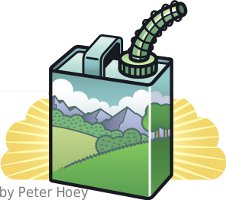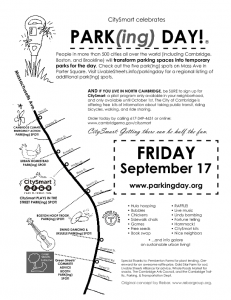 Warm Home Cool Planet is(was) temporarily offline. You might also be interested in the local PARK(ing) Day festivities (PDF).
Warm Home Cool Planet is(was) temporarily offline. You might also be interested in the local PARK(ing) Day festivities (PDF).
Category Archives: Events
Second Annual Urban Ag Fair
| Who: | You | What: | The Second Annual Urban Ag Fair is coming up in Harvard Square just a couple of weeks. If you are a vendor, there is still time to sign up for a table. If you are a foodie who wants to make their opinion heard, there is still time to sign up to be a judge. If you are just a lover of fresh food and want to have a fun free day in Harvard Square, we’ll see you next weekend! |
| When: | September 19th, 11:00 AM to 5:00 PM | |
| Where: | Winthrop Park, Harvard Square | |
| Contact: | www.harvardsquare.com |
Energy Efficiency: Why Is the Low-Hanging Fruit so High?
The Green Light Distrikt has posted video of their even, “Energy Efficiency: Why Is the Low-Hanging Fruit so High?” which occurred a few weeks ago. Panelists included CEA’s community outreach manager Lilah Glick (below) as well as representatives from Wattzy, Next Step Living, EnerNOC and Powerhouse Dynamics. Additional videos of their presentation are available
Continue reading
Green Business Transportation Workshop- 8/25

Brad Winnett from MassRIDES discusses green alternatives while other panelists look on.
On Wednesday August 25th, the Cambridge Energy Alliance and the Sustainable Business Leader Program hosted a Green Transportation Workshop. Panelists discussed ways to make a key facet of business operations, employee transportation, “green.”
Stephanie Anderberg from Cambridge Community Development discussed how businesses can support alternative transportation with help from Pre-tax Commuter Benefits. Basically, these are ways in which businesses can pay for their employees’ green travel (e.g. shuttles, vanpools, biking, the T) before taxes are considered. These can be administered in several fairly easy ways, including giving vouchers or using a 3rd party administrator.
Jim Gascoigne from the Charles River TMA opened with a significant statistic: a staggering 67% of people in Cambridge – an environmentally forward-thinking city – get to work by driving in cars alone. Mr. Gascoigne went on to explain that while the Charles River TMA’s purpose is to reduce traffic congestion and improve air quality, it’s also to help Cambridge citizens reach for more environmentally responsible solutions. Specific services Jim discussed were the public $1 per ride EZride shuttle, which goes to areas around Cambridge that the T does not reach, and an Emergency taxi Ride Home voucher for members.
Brad Winnett from MassRIDES spoke about how his state-wide organization works individually with businesses to incorporate customized combinations of transportation programs that suit their unique circumstances. These combos include ride-sharing, vanpools, biking, walking, the T, and tele-working.
Shane Jordan presented for Mass Bike, a state-wide bicycling advocacy group that supplies many services. Mass Bike Provides three different kinds of 1-hour workshops – general biking, bike maintenance, and one for winter bike-riding. Shane mentioned that Mass Bike has a valet bike parking service, as well as a consulting service. Lastly, Mr. Jordan suggested that if an organization wanted to perform a biking event but didn’t have insurance, they could partner with Mass Bike to be covered under Mass Bike’s insurance.
Zipcar is a membership-based car-sharing service, and was represented on the Green Transportation panel by Matt Kurkowski. Mr. Kurkowski discussed the various benefits of the multiple Zipcar programs and options. Zipcar was what helped one audience member (Janie Katz) transition from 30 years of driving her own car to a no-car diet; others discussed the convenience of the service when traveling for business or for emergencies. For businesses, the Zipcar program is significantly more cost-effective than it might be for the already-affordable personal accounts, making this a great business choice.
After this, Metro Pedal Power (unable to be represented at the event) was discussed thoroughly by the hosts as well as multiple panelists. This company is a local, bike-powered delivery service that provides regularly scheduled as well as on-call deliveries of up to 500 pounds, in all weather. This service makes sense for so ma ny members of the community who may need to transport something only across town, but would otherwise have to ship via UPS or FedEx, whose warehouse check-in point might even be out of state. The service is cost-effective because of the lack of spending on gasoline, and you are reducing the carbon you emit by keeping fossil-fuel-burning vehicles off the road.
ny members of the community who may need to transport something only across town, but would otherwise have to ship via UPS or FedEx, whose warehouse check-in point might even be out of state. The service is cost-effective because of the lack of spending on gasoline, and you are reducing the carbon you emit by keeping fossil-fuel-burning vehicles off the road.
In addition, Janie Katz-Christy, the director of the Green Streets Initiative shared how businesses and employees can get involved in Walk/Ride Days. Walk/Ride Days are on the last Friday of each month, when people can use sustainable transportation and get rewarded by local businesses for doing so. Walk/Ride Days have had excellent results for all kinds of large and small businesses and the Fed DOT is now funding a project to spread Walk/Ride Days to 6 Boston-region communities.
The last mentioned service was that of the downtown-Boston-based Urban Adventours, who offer bike tours throughout the city. This is a great way to get people introduced to the concept of biking as an alternative transportation, as well. For organizations who need bikes to get started, this is one of the bike rental providers in Boston.
——
This workshop was full of organizations who, as a combination, can comprehensively make our community more fossil-fuel independent than ever. I strongly urge you to take advantage of some or all of the services detailed here- and tell your friends!
As always- you may comment here, or email me personally at jgorden@cambridgeenergyalliance.org if you have further questions.
The World Where Oil Flows Free
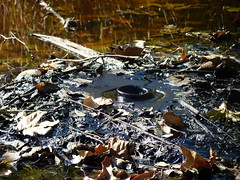 The Gulf Oil Spill has been the event at the top of everyone’s mind for many weeks now, almost to the point of our adapting to the initially shocking concept. The images that have surfaced have been heartrending enough, though, that the shock factor hasn’t been allowed to completely fade. Predictions of the results to come in the next weeks and months are concerning to say the least, and the estimate of how much has been leaking each day continues to rise. BP comes up with a new method to “fix” the problem every few weeks, each seeming promising with a side-serving of bad news. Effects on humans are starting to surface, some gruesome news and some simply tragic projections. With all of this on our plates, it’s understandably hard to think about, let alone discuss, other similar issues.
The Gulf Oil Spill has been the event at the top of everyone’s mind for many weeks now, almost to the point of our adapting to the initially shocking concept. The images that have surfaced have been heartrending enough, though, that the shock factor hasn’t been allowed to completely fade. Predictions of the results to come in the next weeks and months are concerning to say the least, and the estimate of how much has been leaking each day continues to rise. BP comes up with a new method to “fix” the problem every few weeks, each seeming promising with a side-serving of bad news. Effects on humans are starting to surface, some gruesome news and some simply tragic projections. With all of this on our plates, it’s understandably hard to think about, let alone discuss, other similar issues.
One more brick was added to the weight of environmental concern when, on June 11th, another oil spill was reported, this time in Utah. How could an oil spill happen in the middle of the continent? This time it wasn’t an oil rig that failed; in the mountains south of the Great Salt Lake, an oil-transporting pipeline was breached around 10pm. Residents who reported a strong petroleum scent around 7am the next day allowed for the leak to be stopped less than 24 hours after it began. Regardless of the speed with which it was stopped, 33,000 gallons of crude oil were leaked into Salt Lake City creeks and a pond- but not the Lake. Because of the national disappointment with and disdain for the oil giant BP, Chevron responded quickly and aggressively with cleanup devotions.
This leak was obviously a dramatically smaller scale than the spill in the Gulf of Mexico. Instead of a pipeline tapped directly into natural oil stores being busted, a quarter-sized hole was melted in the controllable pipe transporting oil in UT, and it was all over in 24 hours.
The BP underwater pipe has been gushing tens of thousands of gallons each day, for two and a half months. In the UT spill, around 300 Canada Geese and ducks were covered in oil, and fewer than 10 were killed; one endangered fish species was threatened by the spill. The Gulf of Mexico’s biota are threatened in a much, much broader sense- as you might imagine, considering the unimaginable quantity of poison being spewed into the ocean.
While much of the oil spilled in Utah has been cleaned up, the efforts in the Gulf of Mexico have comparatively only just begun. The estimated clean-up time is months, possibly years; the truth is that the effected coastlines (their ecosystems, their businesses, their citizens), especially those closer to the epicenter, may never recover.
While the Gulf oil spill eclipses other fossil fuel issues in the eye of society at present, it also brings an important topic right to the surface of the pile of important current issues, and in some cases inspires reflection.
Would we still be discussing the Utah oil spill, were the BP tragedy not over-shadowing its significance?
The answer is “Maybe not;” spills are not uncommon, mishaps at drilling sites are not uncommon. What makes the BP spill different is the enormous individual scale, proximity to affluent nations, and resulting publicity.
We do not often hear about the ill effects of the oil industry that are happening in less-fortunate regions of our world.
If we ignore the intense sociological disasters surrounding the oil industry in the Niger Delta region of Nigeria, there are statistics to look at that might make the president of BP’s hair curl. It’s estimated that from what are technically Shell and Chevron operations, there are three hundred small and large oil spills in this area each year, due to various factors including oil piracy, aging equipment, and worse-than-poor regulation. In this undeveloped region where locals see no benefit from the industry, oil spills surround the villages. An image of the ruined environment was painted potently by one BBC article;
“Visitors to the Nigerian village of Kpor, deep in the Niger Delta, are greeted by strange sights: silver frogs blink from gleaming puddles, sunlight bounces from an eerie black lake, and dragonflies hover over cauldrons of tar.”
This is a generally unillustrated tragedy, an example of what we are not seeing through the corporate veil. Information is not exposed for many reasons- too many to discuss here- but these events are significant enough to spend time digging for.
—-
Discussed above are only the results of our addiction to oil. What about the other common fossil fuels that we depend on? If we disregard the carbon emissions and their effects, related to burning any fossil fuels-
- Coal mining means mountain tops destroyed, geology and topography both obliterated as removed mountain tops are filled into valleys; this is not to mention the pollution nightmares that come along with mining, or the health risks: 11,000+ injured (lowest number ever recorded), 69 killed most recently.
- Natural gas mining–hydraulic fracturing/fracking— creates air-polluting ground-level ozone, poisons the surrounding groundwater and has severe effects on surrounding communities.
Maintenance of our presently strong socioeconomic bonds to fossil fuels are already fatal, both to operators and the surrounding environment. What will it be like when these limited resources begin to truly dwindle, when, if we haven’t changed the juice our society runs on, we are mining every potentially coal-filled mountain and drilling into every oil deposit the earth’s crust has left to offer? We can be assured worker safety and environmental health will not be more of a priority then, in the hour of desperation, than it is now.
It seems that now is time to start using the information we have already to start making changes in the way our energy system works.This is not to say that there won’t be risks associated with other energy practices, but after looking at the information surrounding the above-mentioned options, I would argue that finding an environmentally-friendly energy option that posed the same level of human and environmental health risks would be difficult. Environmental safety is an inherent property of an environmentally-friendly product, afterall.
Gubernatorial Forum- Energy & Environment
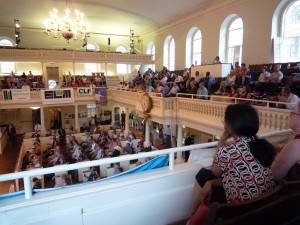 On June 29th, a two-hour gubernatorial forum was held in downtown Boston’s historic Old South Meeting House.
On June 29th, a two-hour gubernatorial forum was held in downtown Boston’s historic Old South Meeting House.
All candidates for Governor were welcomed to make a statement, followed by a short Q&A by the audience and two panelists.
The first candidate to speak, Governor Deval Patrick, spoke about Cape Wind, and addressed a question about the alternative of purchasing clean energy from other places, if it were cheaper than producing our own. In response to this, he unwittingly quoted Chairman Mao, “I don’t know who said it, but, we’re going to have to let a thousand flowers bloom,” and concluded that we’ve still got a long way to go, and no avenue should be left unexplored. Other topics he discussed were the state of parks after cut funding, the Evergreen Solar project and Chapter 40B. The overall theme for the Governor’s discussion was that “we have got a long way to go,” but the place Massachusetts is in now shows important progress.
The first new candidate to speak, Dr. Jill Stein of the Rainbow Green party, discussed passionately–
- The need for transparency in government
- The significance of Environmental Health factors as relate to human health and health costs
- What she would like to change about taxes: She’d like to increase income taxes & reduce sales tax with goal of benefiting the lower & middle income folks who spend a higher percentage of their income on consumption. -But ultimately she would like to move towards a carbon tax.
- Environmental Health issues – open communication of risks including a personal battle- mercury in fish
After Dr. Stein’s enthused and in depth discussion of environmental health and taxes, State Treasurer Tim Cahill took the podium. Mr. Treasurer announced right off the bat his less-detailed knowledge of environmental sciences, and the fact that his main goal was “jobs” and that it would inevitably mean clashing with environmentalists at times. He attempted to stress that he listens to all opinions before making decisions, but if it were environment versus development, he would unquestionably favor development.
Republican candidate Charles Baker had a previous speaking engagement, but he was represented at the event by Senate minority leader Bradley Jones. Mr. Jones was able to clarify that though Mr. Baker may not see that global warming is being caused by anthropogenic activities, he was able to see practicality, economical, and health-related reasons for fighting for cleaner practices.
State primaries will be held September 14, 2010, followed by elections for Governor on November 9, 2010.
King Corn, 1st in Environmental Film Series
 Several Boston/Cambridge groups have collectively organized an open-ended Environmental Film series, the kick-off of which was this past Tuesday, at Cambridge’s Main Library. The second film in the series, Kilowatt Ours, will be shown on July 29th in the same location: Bottom floor (L2), Cambridge Main Library, 449 Broadway, Cambridge, MA 02138-4191 at 6:30pm. Another (yet to be selected) film will be shown on August 19th, so save this date!
Several Boston/Cambridge groups have collectively organized an open-ended Environmental Film series, the kick-off of which was this past Tuesday, at Cambridge’s Main Library. The second film in the series, Kilowatt Ours, will be shown on July 29th in the same location: Bottom floor (L2), Cambridge Main Library, 449 Broadway, Cambridge, MA 02138-4191 at 6:30pm. Another (yet to be selected) film will be shown on August 19th, so save this date!
The first documentary “King Corn” was shown at 6:30 and light refreshments were served afterward.
This film follows two young men who, after finding corn molecules in strands of their hair, trace their genealogical footsteps back to their Iowan homeland and learn that the land their ancestors once farmed is covered in corn. Not just corn, but a variety of corn that can’t even be eaten.
To fully understand today’s agriculture system, the two guys arrange to purchase and register one acre of land, on which they go through all of the expected farming measures to create maximum yield. While their 31,000 seeds are growing into full-sized high-yield cornstock, these gentlemen explore what happens to the starchy corn they are now growing once it leaves their farm. The corn is used several ways, none of them direct human consumption. Cows on beef farms are fed with it, some of it is exported or used for ethanol, and a vast amount of it goes into becoming a sweetener—high fructose corn syrup. They go on to find that the corn in their hair came not necessarily (and certainly not solely) from eating actual corn, but from everything else they were consuming, including products like beef, bread, soda, chicken, french fries, and spaghetti sauces. This is a timely film that takes a hard look at the farming industry in the US today, the use of our bread basket for something we can’t eat, the beef industry, and the ubiquity of corn syrup in today’s society, among other significant topics.
Some eye-opening facts mentioned in this film:
- The type of corn grown all over Iowa today is bred to be starchy, and to tolerate close planting- resulting in almost 10,000 pounds of corn being produced on each acre, and none of it edible.
- More than half of the corn crop goes into feed for animals, mainly cows (i.e. beef farms).
From the movie:
- The meat that we eat in this day and age is produced in a feed lot.
- It’s grain-fed meat, and we produce a characteristically obese animal, animals whose muscle tissue looks more like fat tissue than it does lean meat in wild animals.
- …if you look at a T-bone steak from a grain-fed cow, it may have as much as 9 grams of saturated fat; whereas a comparable steak from a grass-fed animal would have 1.3 grams of saturated fat.
- Meat cows that are not butchered within two years on this diet will die from the acidosis the corn causes.
- 70% of the antiobiotics used in the U.S. are those given to livestock- a large portion of which are for beef to fight off the acidosis.
- The corn a farmer produces cannot sustain him- he will always come out with a deficit when comparing produce value to the cost of production. The reason they stay afloat (if they do) is because of government subsidies.
- The over-production of corn in the U.S. is looked on by some as a plus- an asset. The roots of this lie with the history of farming, and the portion of income it used to take to feed a family.
- Corn syrup is in everything from kool-aid (as expected) to spaghetti sauces and breads (for “browning qualities”–less expected). [Challenge yourself to find items in your home that do NOT have corn syrup- you will be surprised- only two portions of our after-film refreshments did not have corn syrup!]
As you may have grasped, I highly recommend seeing this documentary, and sharing it with everyone you know. The film is not only highly informative in an easy to comprehend way, but it has got a strong vein of humor woven throughout the eye-opening footage. Here’s the trailer:
Burning breakfasts for bus fuel
Although the specifics may have since changed, this chart from Bio Hope, Bio Hype in the September 2007 issue of the Sierra Club’s magazine provides a nice overview of the major biofuel options.
What about moving Beyond the Corn Field: Balancing Fuel, Food and Biodiversity? After all, if there’s one thing that thing that our reliance on fossilized sunlight has taught us, it’s that that there should be room for every fuel that makes ecological (and economic) sense. Indeed, there are a number of exotic fuel feedstocks you are probably not yet familiar with. Indeed, on Earth Day the Navy tested a bio-blend jet fuel made from 50% German sesame seed oil. What of the much touted cellulosic ethanol? An alternative to the use of sugary food crops, or the relatively low-yield plant-based oils. In February University of Wisconsin researchers published a paper with details about a mechanism for efficiently converting an intermediate product that may be derived from sugar or cellulose into a high-grade liquid fuel.
Despite these and other advancements, more evidence is coming to light that biofuels are not without ecological costs including biodiversity as linked above, and soil degradation. In the end, it will be a balancing act, with conservation and efficiency offering the highest yield.
While not specifically about biofuels, the agri-business exposé King Corn is being shown at the Main Library next Tuesday evening; it has its detractors though.
Green Your Marketing! Workshop Review
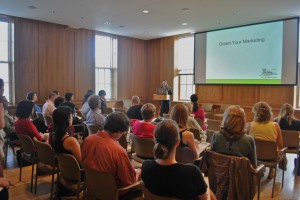 Thanks to Emily Kanter at the Sustainable Business Leader Program & CEA‘s Lilah Glick, a group of Cambridge’s small business leaders were able to come together for a Green Marketing workshop on June 17th, led by Leah Bloom, the media-proclaimed “green business guru.”
Thanks to Emily Kanter at the Sustainable Business Leader Program & CEA‘s Lilah Glick, a group of Cambridge’s small business leaders were able to come together for a Green Marketing workshop on June 17th, led by Leah Bloom, the media-proclaimed “green business guru.”
Continue reading
Drink Local, Hike Local too
 CCTV blogger Karen Klinger has an interesting write-up of her stroll around the birthplace of your drinking water last Monday evening. Should you find the tale inspiring, you have two more chances to take part in a guided tour of the upper watershed, and three of Fresh pond. If you attend, or otherwise visit Fresh Pond check out some of the interesting 1) public 2) art versions of the watershed map:
CCTV blogger Karen Klinger has an interesting write-up of her stroll around the birthplace of your drinking water last Monday evening. Should you find the tale inspiring, you have two more chances to take part in a guided tour of the upper watershed, and three of Fresh pond. If you attend, or otherwise visit Fresh Pond check out some of the interesting 1) public 2) art versions of the watershed map:

